Early Childhood Assessment Report: Analyzing a Toddler's Development
VerifiedAdded on 2023/01/23
|13
|3368
|53
Report
AI Summary
This report presents a student's assessment of a 23-month-old toddler, focusing on the child's development, particularly in language and communication. The student observed the child over a week, noting the child's understanding but difficulty in speaking. The report details the assessment process, including interactions with the child using blocks and nonverbal cues. It analyzes the child's responses and compares them to typical developmental milestones, highlighting the importance of communication and the challenges faced by the child. The report further discusses the pedagogical significance of the assessment, emphasizing the use of dialogue and object-based communication in early childhood education. It also explores the student's feelings and observations during the assessment, providing a comprehensive overview of the child's development and the assessment process.
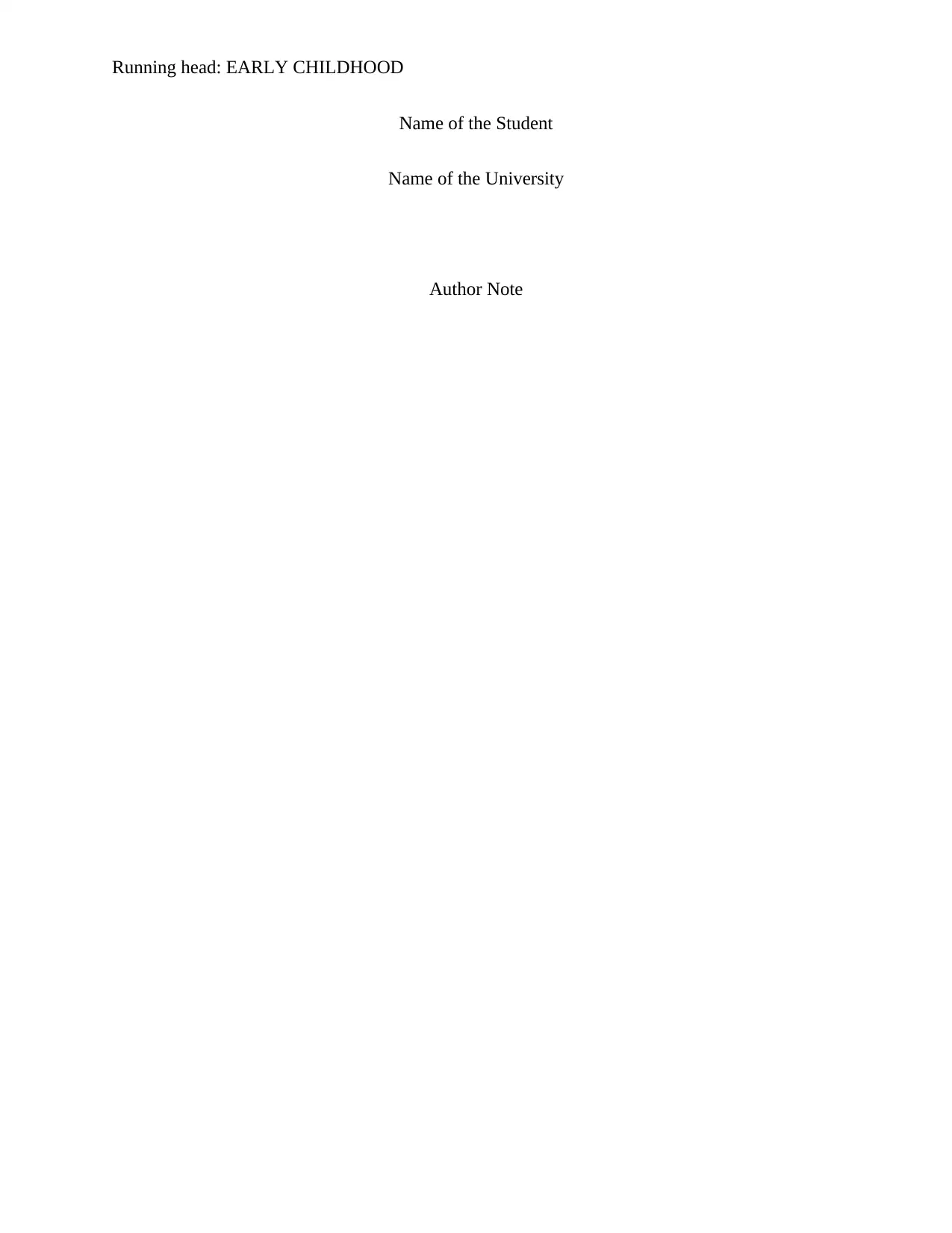
Running head: EARLY CHILDHOOD
Name of the Student
Name of the University
Author Note
Name of the Student
Name of the University
Author Note
Paraphrase This Document
Need a fresh take? Get an instant paraphrase of this document with our AI Paraphraser
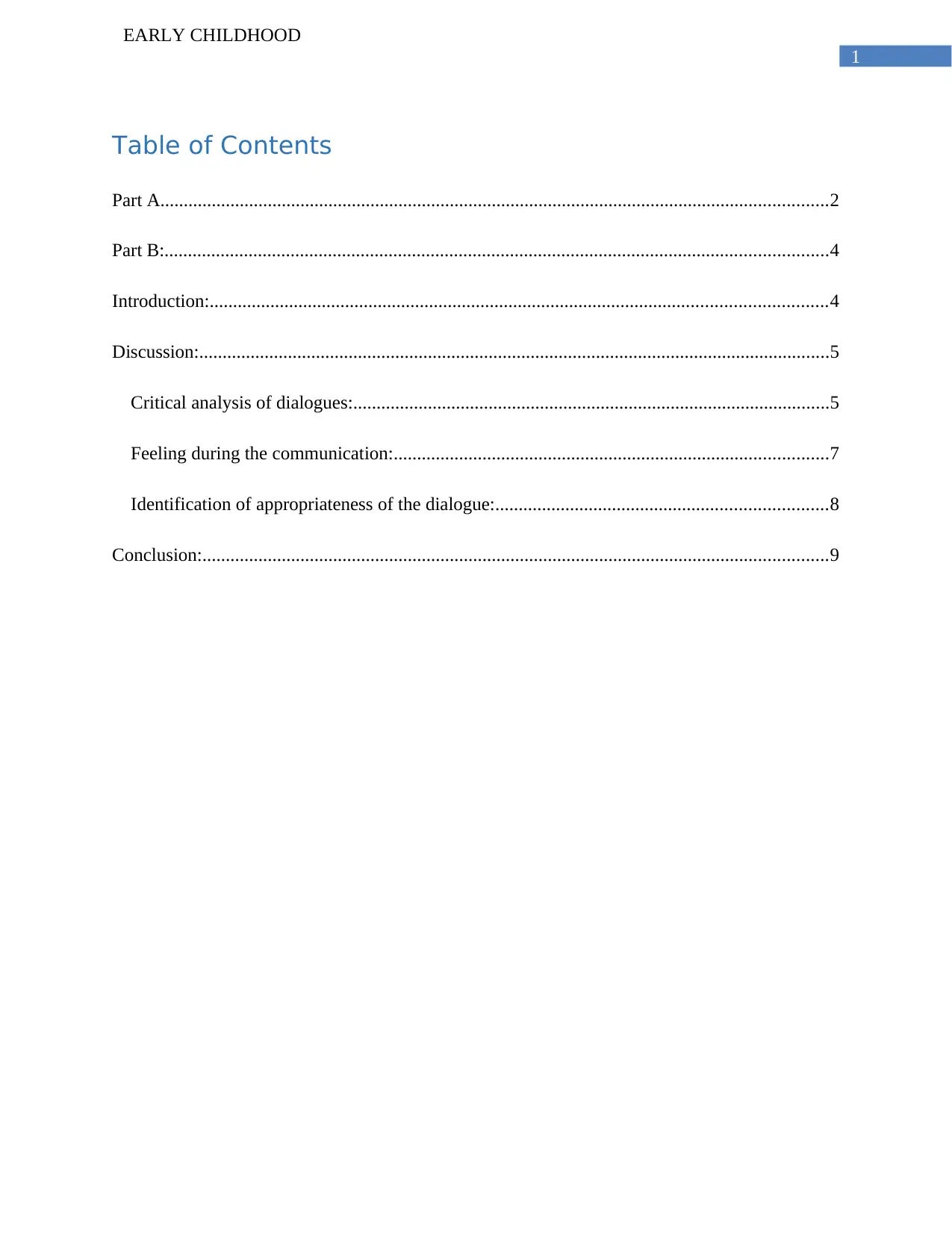
1
EARLY CHILDHOOD
Table of Contents
Part A...............................................................................................................................................2
Part B:..............................................................................................................................................4
Introduction:....................................................................................................................................4
Discussion:.......................................................................................................................................5
Critical analysis of dialogues:......................................................................................................5
Feeling during the communication:.............................................................................................7
Identification of appropriateness of the dialogue:.......................................................................8
Conclusion:......................................................................................................................................9
EARLY CHILDHOOD
Table of Contents
Part A...............................................................................................................................................2
Part B:..............................................................................................................................................4
Introduction:....................................................................................................................................4
Discussion:.......................................................................................................................................5
Critical analysis of dialogues:......................................................................................................5
Feeling during the communication:.............................................................................................7
Identification of appropriateness of the dialogue:.......................................................................8
Conclusion:......................................................................................................................................9
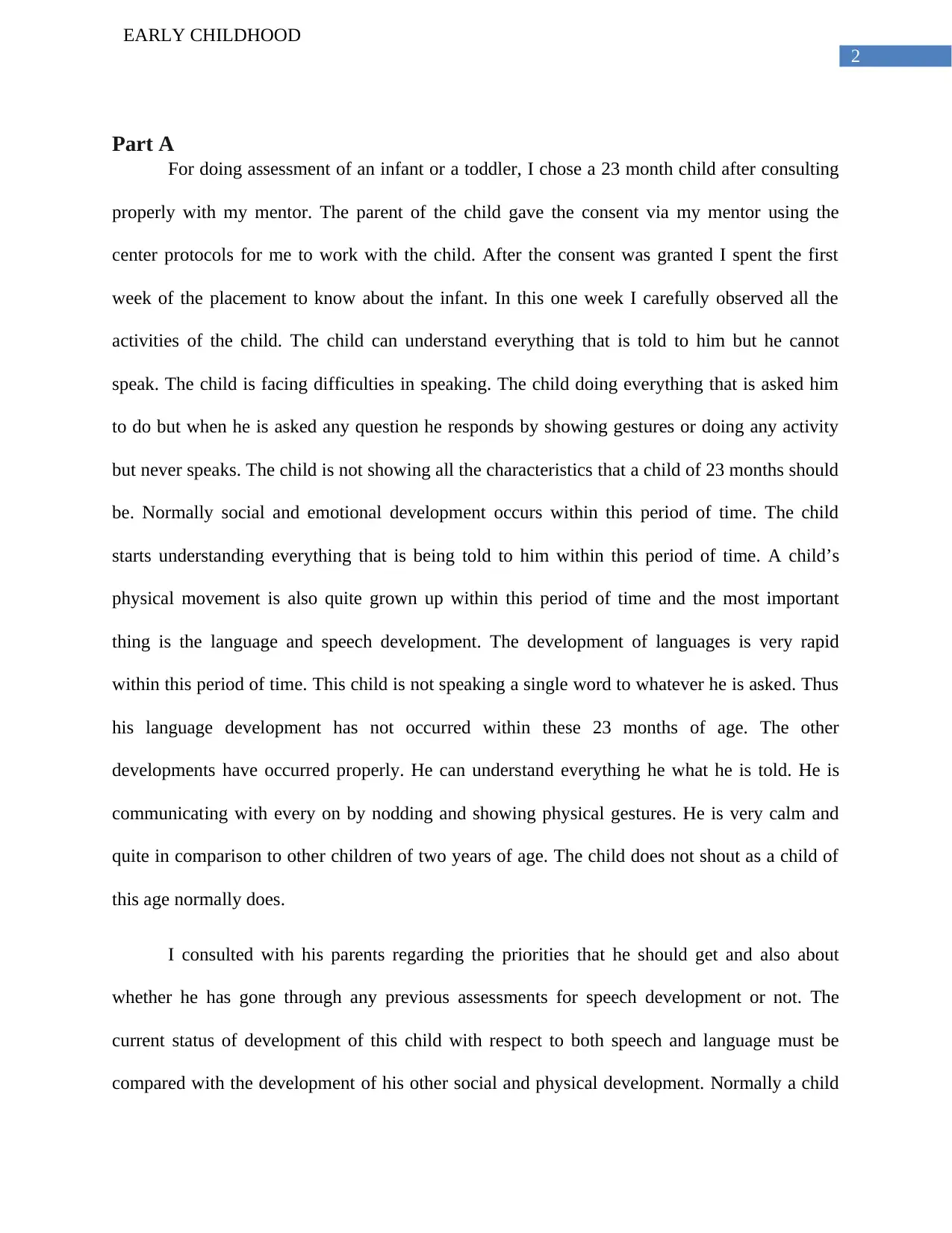
2
EARLY CHILDHOOD
Part A
For doing assessment of an infant or a toddler, I chose a 23 month child after consulting
properly with my mentor. The parent of the child gave the consent via my mentor using the
center protocols for me to work with the child. After the consent was granted I spent the first
week of the placement to know about the infant. In this one week I carefully observed all the
activities of the child. The child can understand everything that is told to him but he cannot
speak. The child is facing difficulties in speaking. The child doing everything that is asked him
to do but when he is asked any question he responds by showing gestures or doing any activity
but never speaks. The child is not showing all the characteristics that a child of 23 months should
be. Normally social and emotional development occurs within this period of time. The child
starts understanding everything that is being told to him within this period of time. A child’s
physical movement is also quite grown up within this period of time and the most important
thing is the language and speech development. The development of languages is very rapid
within this period of time. This child is not speaking a single word to whatever he is asked. Thus
his language development has not occurred within these 23 months of age. The other
developments have occurred properly. He can understand everything he what he is told. He is
communicating with every on by nodding and showing physical gestures. He is very calm and
quite in comparison to other children of two years of age. The child does not shout as a child of
this age normally does.
I consulted with his parents regarding the priorities that he should get and also about
whether he has gone through any previous assessments for speech development or not. The
current status of development of this child with respect to both speech and language must be
compared with the development of his other social and physical development. Normally a child
EARLY CHILDHOOD
Part A
For doing assessment of an infant or a toddler, I chose a 23 month child after consulting
properly with my mentor. The parent of the child gave the consent via my mentor using the
center protocols for me to work with the child. After the consent was granted I spent the first
week of the placement to know about the infant. In this one week I carefully observed all the
activities of the child. The child can understand everything that is told to him but he cannot
speak. The child is facing difficulties in speaking. The child doing everything that is asked him
to do but when he is asked any question he responds by showing gestures or doing any activity
but never speaks. The child is not showing all the characteristics that a child of 23 months should
be. Normally social and emotional development occurs within this period of time. The child
starts understanding everything that is being told to him within this period of time. A child’s
physical movement is also quite grown up within this period of time and the most important
thing is the language and speech development. The development of languages is very rapid
within this period of time. This child is not speaking a single word to whatever he is asked. Thus
his language development has not occurred within these 23 months of age. The other
developments have occurred properly. He can understand everything he what he is told. He is
communicating with every on by nodding and showing physical gestures. He is very calm and
quite in comparison to other children of two years of age. The child does not shout as a child of
this age normally does.
I consulted with his parents regarding the priorities that he should get and also about
whether he has gone through any previous assessments for speech development or not. The
current status of development of this child with respect to both speech and language must be
compared with the development of his other social and physical development. Normally a child
⊘ This is a preview!⊘
Do you want full access?
Subscribe today to unlock all pages.

Trusted by 1+ million students worldwide
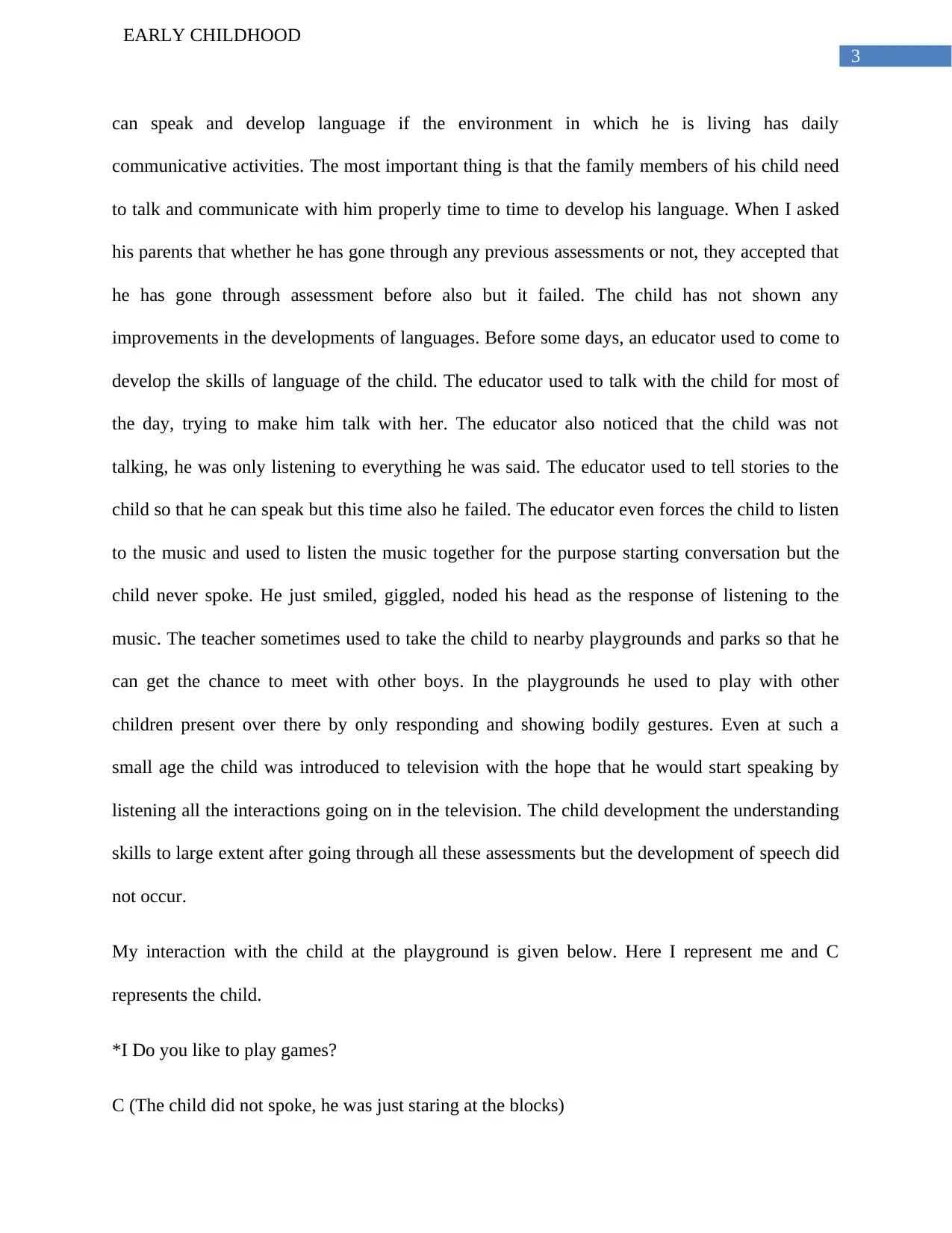
3
EARLY CHILDHOOD
can speak and develop language if the environment in which he is living has daily
communicative activities. The most important thing is that the family members of his child need
to talk and communicate with him properly time to time to develop his language. When I asked
his parents that whether he has gone through any previous assessments or not, they accepted that
he has gone through assessment before also but it failed. The child has not shown any
improvements in the developments of languages. Before some days, an educator used to come to
develop the skills of language of the child. The educator used to talk with the child for most of
the day, trying to make him talk with her. The educator also noticed that the child was not
talking, he was only listening to everything he was said. The educator used to tell stories to the
child so that he can speak but this time also he failed. The educator even forces the child to listen
to the music and used to listen the music together for the purpose starting conversation but the
child never spoke. He just smiled, giggled, noded his head as the response of listening to the
music. The teacher sometimes used to take the child to nearby playgrounds and parks so that he
can get the chance to meet with other boys. In the playgrounds he used to play with other
children present over there by only responding and showing bodily gestures. Even at such a
small age the child was introduced to television with the hope that he would start speaking by
listening all the interactions going on in the television. The child development the understanding
skills to large extent after going through all these assessments but the development of speech did
not occur.
My interaction with the child at the playground is given below. Here I represent me and C
represents the child.
*I Do you like to play games?
C (The child did not spoke, he was just staring at the blocks)
EARLY CHILDHOOD
can speak and develop language if the environment in which he is living has daily
communicative activities. The most important thing is that the family members of his child need
to talk and communicate with him properly time to time to develop his language. When I asked
his parents that whether he has gone through any previous assessments or not, they accepted that
he has gone through assessment before also but it failed. The child has not shown any
improvements in the developments of languages. Before some days, an educator used to come to
develop the skills of language of the child. The educator used to talk with the child for most of
the day, trying to make him talk with her. The educator also noticed that the child was not
talking, he was only listening to everything he was said. The educator used to tell stories to the
child so that he can speak but this time also he failed. The educator even forces the child to listen
to the music and used to listen the music together for the purpose starting conversation but the
child never spoke. He just smiled, giggled, noded his head as the response of listening to the
music. The teacher sometimes used to take the child to nearby playgrounds and parks so that he
can get the chance to meet with other boys. In the playgrounds he used to play with other
children present over there by only responding and showing bodily gestures. Even at such a
small age the child was introduced to television with the hope that he would start speaking by
listening all the interactions going on in the television. The child development the understanding
skills to large extent after going through all these assessments but the development of speech did
not occur.
My interaction with the child at the playground is given below. Here I represent me and C
represents the child.
*I Do you like to play games?
C (The child did not spoke, he was just staring at the blocks)
Paraphrase This Document
Need a fresh take? Get an instant paraphrase of this document with our AI Paraphraser
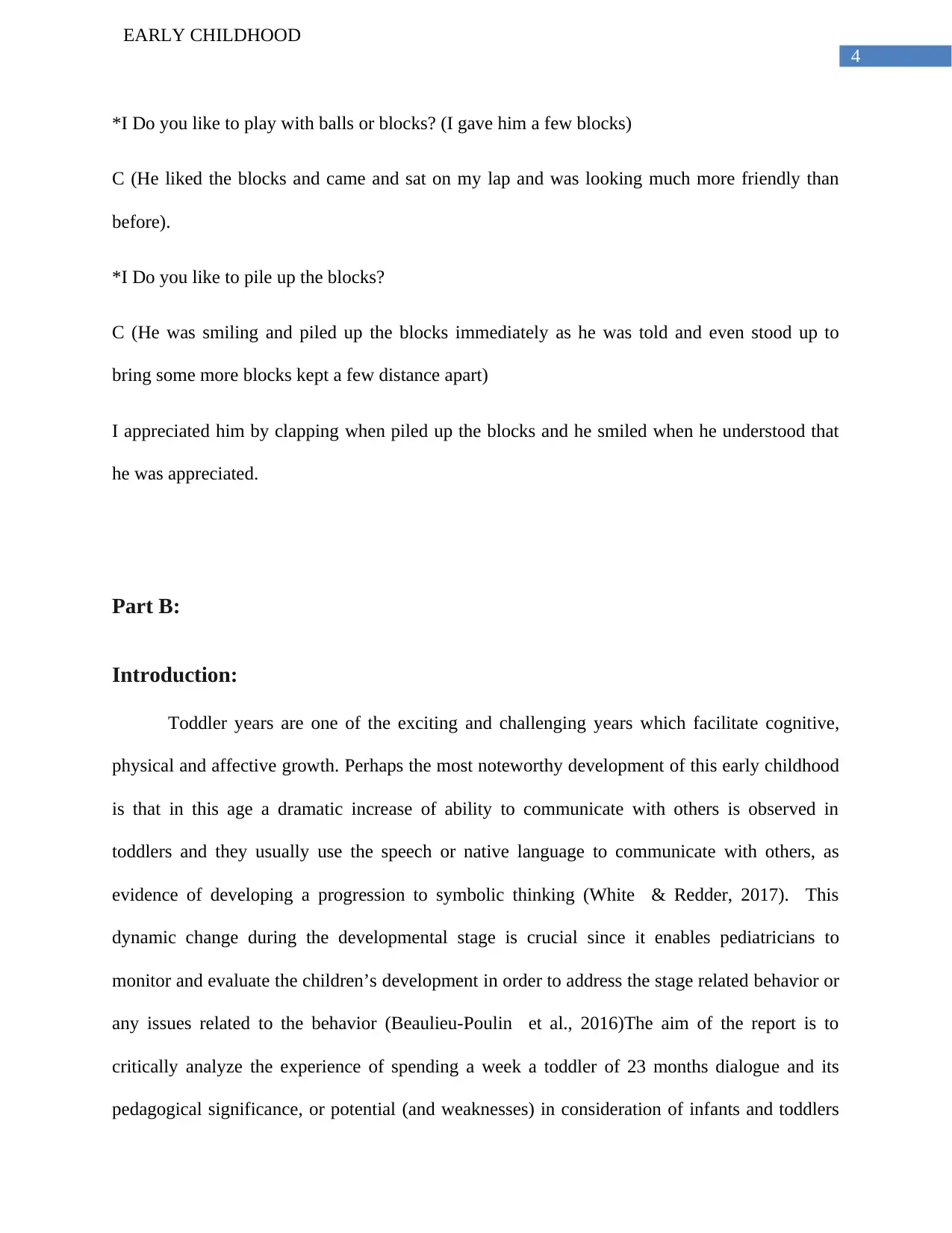
4
EARLY CHILDHOOD
*I Do you like to play with balls or blocks? (I gave him a few blocks)
C (He liked the blocks and came and sat on my lap and was looking much more friendly than
before).
*I Do you like to pile up the blocks?
C (He was smiling and piled up the blocks immediately as he was told and even stood up to
bring some more blocks kept a few distance apart)
I appreciated him by clapping when piled up the blocks and he smiled when he understood that
he was appreciated.
Part B:
Introduction:
Toddler years are one of the exciting and challenging years which facilitate cognitive,
physical and affective growth. Perhaps the most noteworthy development of this early childhood
is that in this age a dramatic increase of ability to communicate with others is observed in
toddlers and they usually use the speech or native language to communicate with others, as
evidence of developing a progression to symbolic thinking (White & Redder, 2017). This
dynamic change during the developmental stage is crucial since it enables pediatricians to
monitor and evaluate the children’s development in order to address the stage related behavior or
any issues related to the behavior (Beaulieu-Poulin et al., 2016)The aim of the report is to
critically analyze the experience of spending a week a toddler of 23 months dialogue and its
pedagogical significance, or potential (and weaknesses) in consideration of infants and toddlers
EARLY CHILDHOOD
*I Do you like to play with balls or blocks? (I gave him a few blocks)
C (He liked the blocks and came and sat on my lap and was looking much more friendly than
before).
*I Do you like to pile up the blocks?
C (He was smiling and piled up the blocks immediately as he was told and even stood up to
bring some more blocks kept a few distance apart)
I appreciated him by clapping when piled up the blocks and he smiled when he understood that
he was appreciated.
Part B:
Introduction:
Toddler years are one of the exciting and challenging years which facilitate cognitive,
physical and affective growth. Perhaps the most noteworthy development of this early childhood
is that in this age a dramatic increase of ability to communicate with others is observed in
toddlers and they usually use the speech or native language to communicate with others, as
evidence of developing a progression to symbolic thinking (White & Redder, 2017). This
dynamic change during the developmental stage is crucial since it enables pediatricians to
monitor and evaluate the children’s development in order to address the stage related behavior or
any issues related to the behavior (Beaulieu-Poulin et al., 2016)The aim of the report is to
critically analyze the experience of spending a week a toddler of 23 months dialogue and its
pedagogical significance, or potential (and weaknesses) in consideration of infants and toddlers
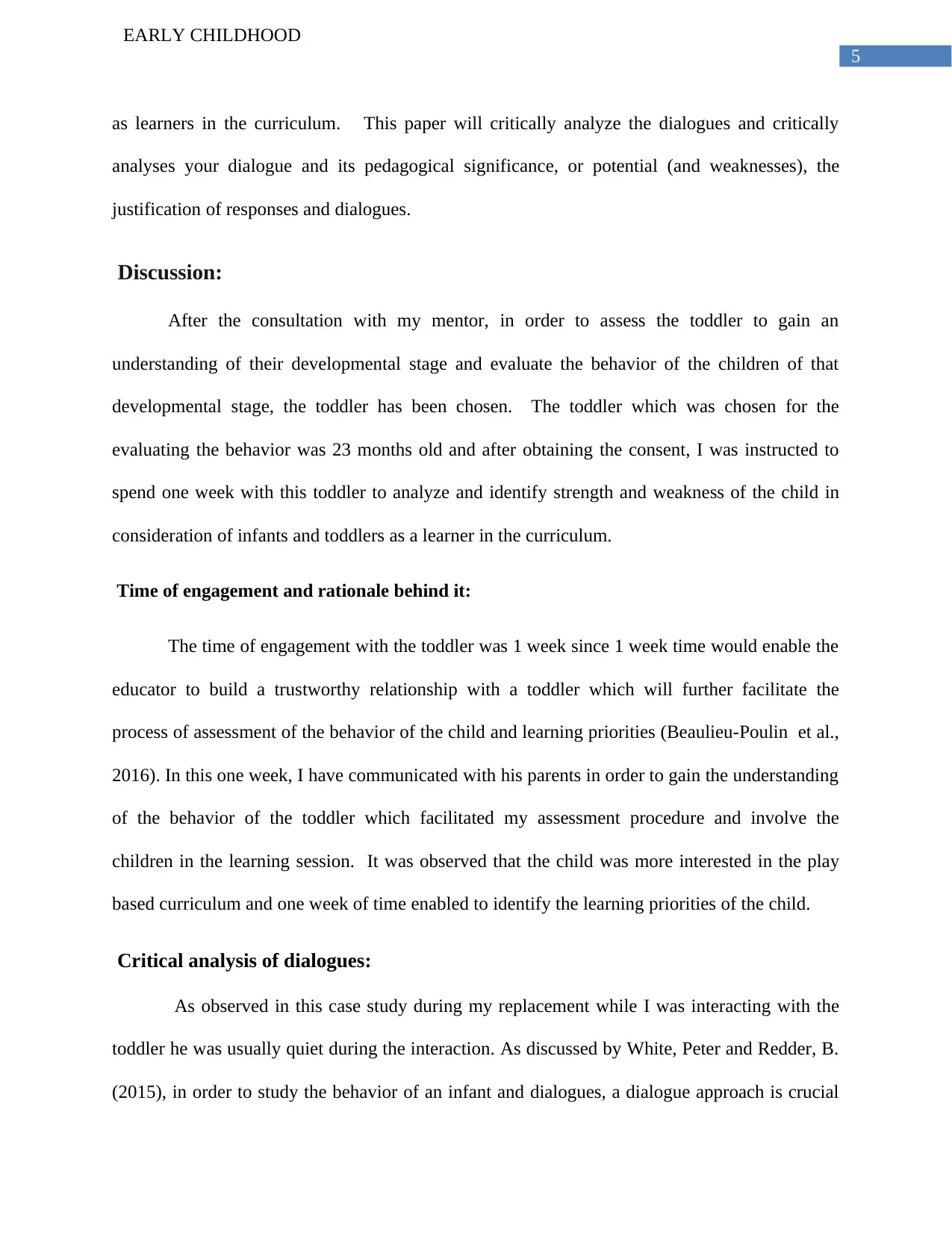
5
EARLY CHILDHOOD
as learners in the curriculum. This paper will critically analyze the dialogues and critically
analyses your dialogue and its pedagogical significance, or potential (and weaknesses), the
justification of responses and dialogues.
Discussion:
After the consultation with my mentor, in order to assess the toddler to gain an
understanding of their developmental stage and evaluate the behavior of the children of that
developmental stage, the toddler has been chosen. The toddler which was chosen for the
evaluating the behavior was 23 months old and after obtaining the consent, I was instructed to
spend one week with this toddler to analyze and identify strength and weakness of the child in
consideration of infants and toddlers as a learner in the curriculum.
Time of engagement and rationale behind it:
The time of engagement with the toddler was 1 week since 1 week time would enable the
educator to build a trustworthy relationship with a toddler which will further facilitate the
process of assessment of the behavior of the child and learning priorities (Beaulieu-Poulin et al.,
2016). In this one week, I have communicated with his parents in order to gain the understanding
of the behavior of the toddler which facilitated my assessment procedure and involve the
children in the learning session. It was observed that the child was more interested in the play
based curriculum and one week of time enabled to identify the learning priorities of the child.
Critical analysis of dialogues:
As observed in this case study during my replacement while I was interacting with the
toddler he was usually quiet during the interaction. As discussed by White, Peter and Redder, B.
(2015), in order to study the behavior of an infant and dialogues, a dialogue approach is crucial
EARLY CHILDHOOD
as learners in the curriculum. This paper will critically analyze the dialogues and critically
analyses your dialogue and its pedagogical significance, or potential (and weaknesses), the
justification of responses and dialogues.
Discussion:
After the consultation with my mentor, in order to assess the toddler to gain an
understanding of their developmental stage and evaluate the behavior of the children of that
developmental stage, the toddler has been chosen. The toddler which was chosen for the
evaluating the behavior was 23 months old and after obtaining the consent, I was instructed to
spend one week with this toddler to analyze and identify strength and weakness of the child in
consideration of infants and toddlers as a learner in the curriculum.
Time of engagement and rationale behind it:
The time of engagement with the toddler was 1 week since 1 week time would enable the
educator to build a trustworthy relationship with a toddler which will further facilitate the
process of assessment of the behavior of the child and learning priorities (Beaulieu-Poulin et al.,
2016). In this one week, I have communicated with his parents in order to gain the understanding
of the behavior of the toddler which facilitated my assessment procedure and involve the
children in the learning session. It was observed that the child was more interested in the play
based curriculum and one week of time enabled to identify the learning priorities of the child.
Critical analysis of dialogues:
As observed in this case study during my replacement while I was interacting with the
toddler he was usually quiet during the interaction. As discussed by White, Peter and Redder, B.
(2015), in order to study the behavior of an infant and dialogues, a dialogue approach is crucial
⊘ This is a preview!⊘
Do you want full access?
Subscribe today to unlock all pages.

Trusted by 1+ million students worldwide
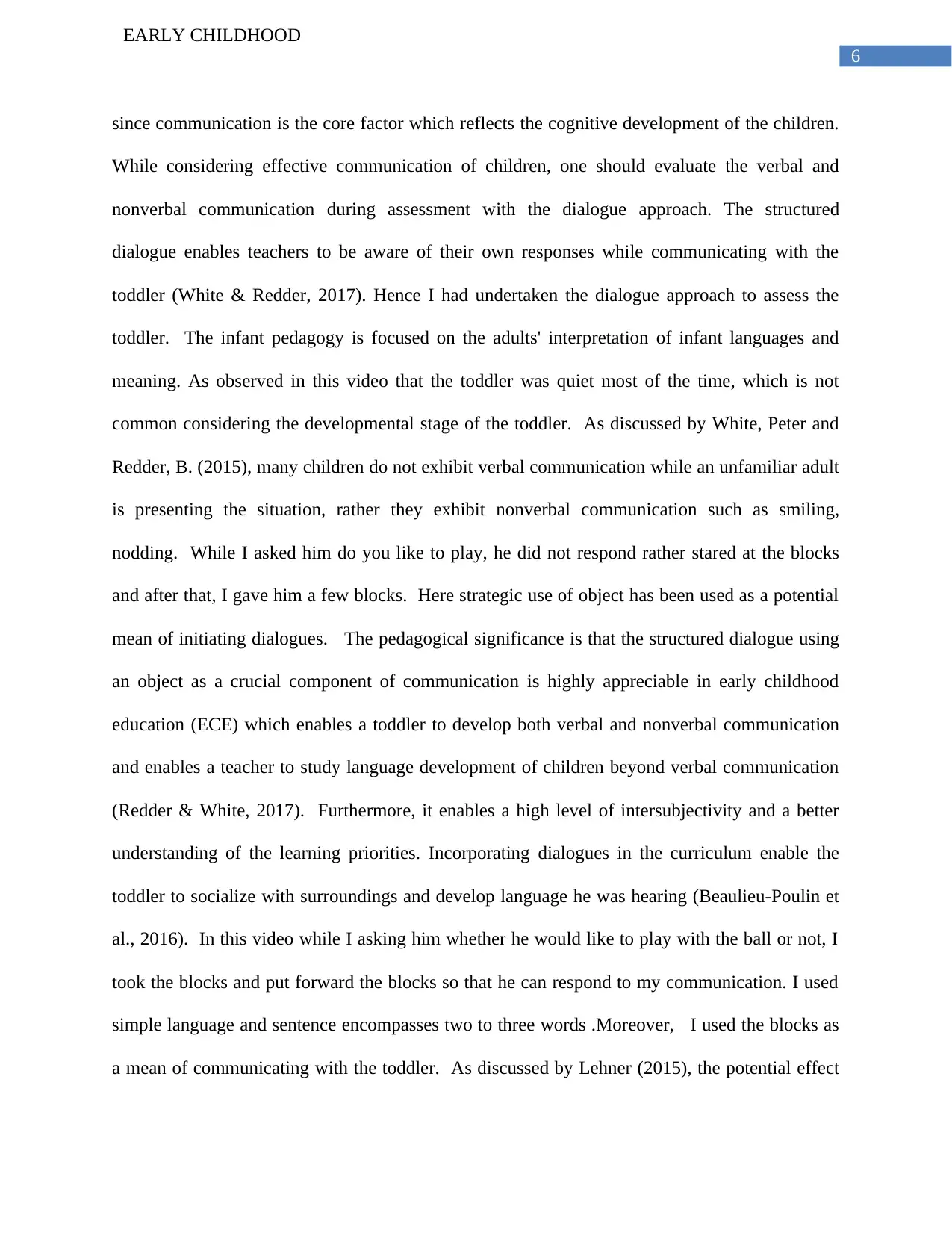
6
EARLY CHILDHOOD
since communication is the core factor which reflects the cognitive development of the children.
While considering effective communication of children, one should evaluate the verbal and
nonverbal communication during assessment with the dialogue approach. The structured
dialogue enables teachers to be aware of their own responses while communicating with the
toddler (White & Redder, 2017). Hence I had undertaken the dialogue approach to assess the
toddler. The infant pedagogy is focused on the adults' interpretation of infant languages and
meaning. As observed in this video that the toddler was quiet most of the time, which is not
common considering the developmental stage of the toddler. As discussed by White, Peter and
Redder, B. (2015), many children do not exhibit verbal communication while an unfamiliar adult
is presenting the situation, rather they exhibit nonverbal communication such as smiling,
nodding. While I asked him do you like to play, he did not respond rather stared at the blocks
and after that, I gave him a few blocks. Here strategic use of object has been used as a potential
mean of initiating dialogues. The pedagogical significance is that the structured dialogue using
an object as a crucial component of communication is highly appreciable in early childhood
education (ECE) which enables a toddler to develop both verbal and nonverbal communication
and enables a teacher to study language development of children beyond verbal communication
(Redder & White, 2017). Furthermore, it enables a high level of intersubjectivity and a better
understanding of the learning priorities. Incorporating dialogues in the curriculum enable the
toddler to socialize with surroundings and develop language he was hearing (Beaulieu-Poulin et
al., 2016). In this video while I asking him whether he would like to play with the ball or not, I
took the blocks and put forward the blocks so that he can respond to my communication. I used
simple language and sentence encompasses two to three words .Moreover, I used the blocks as
a mean of communicating with the toddler. As discussed by Lehner (2015), the potential effect
EARLY CHILDHOOD
since communication is the core factor which reflects the cognitive development of the children.
While considering effective communication of children, one should evaluate the verbal and
nonverbal communication during assessment with the dialogue approach. The structured
dialogue enables teachers to be aware of their own responses while communicating with the
toddler (White & Redder, 2017). Hence I had undertaken the dialogue approach to assess the
toddler. The infant pedagogy is focused on the adults' interpretation of infant languages and
meaning. As observed in this video that the toddler was quiet most of the time, which is not
common considering the developmental stage of the toddler. As discussed by White, Peter and
Redder, B. (2015), many children do not exhibit verbal communication while an unfamiliar adult
is presenting the situation, rather they exhibit nonverbal communication such as smiling,
nodding. While I asked him do you like to play, he did not respond rather stared at the blocks
and after that, I gave him a few blocks. Here strategic use of object has been used as a potential
mean of initiating dialogues. The pedagogical significance is that the structured dialogue using
an object as a crucial component of communication is highly appreciable in early childhood
education (ECE) which enables a toddler to develop both verbal and nonverbal communication
and enables a teacher to study language development of children beyond verbal communication
(Redder & White, 2017). Furthermore, it enables a high level of intersubjectivity and a better
understanding of the learning priorities. Incorporating dialogues in the curriculum enable the
toddler to socialize with surroundings and develop language he was hearing (Beaulieu-Poulin et
al., 2016). In this video while I asking him whether he would like to play with the ball or not, I
took the blocks and put forward the blocks so that he can respond to my communication. I used
simple language and sentence encompasses two to three words .Moreover, I used the blocks as
a mean of communicating with the toddler. As discussed by Lehner (2015), the potential effect
Paraphrase This Document
Need a fresh take? Get an instant paraphrase of this document with our AI Paraphraser
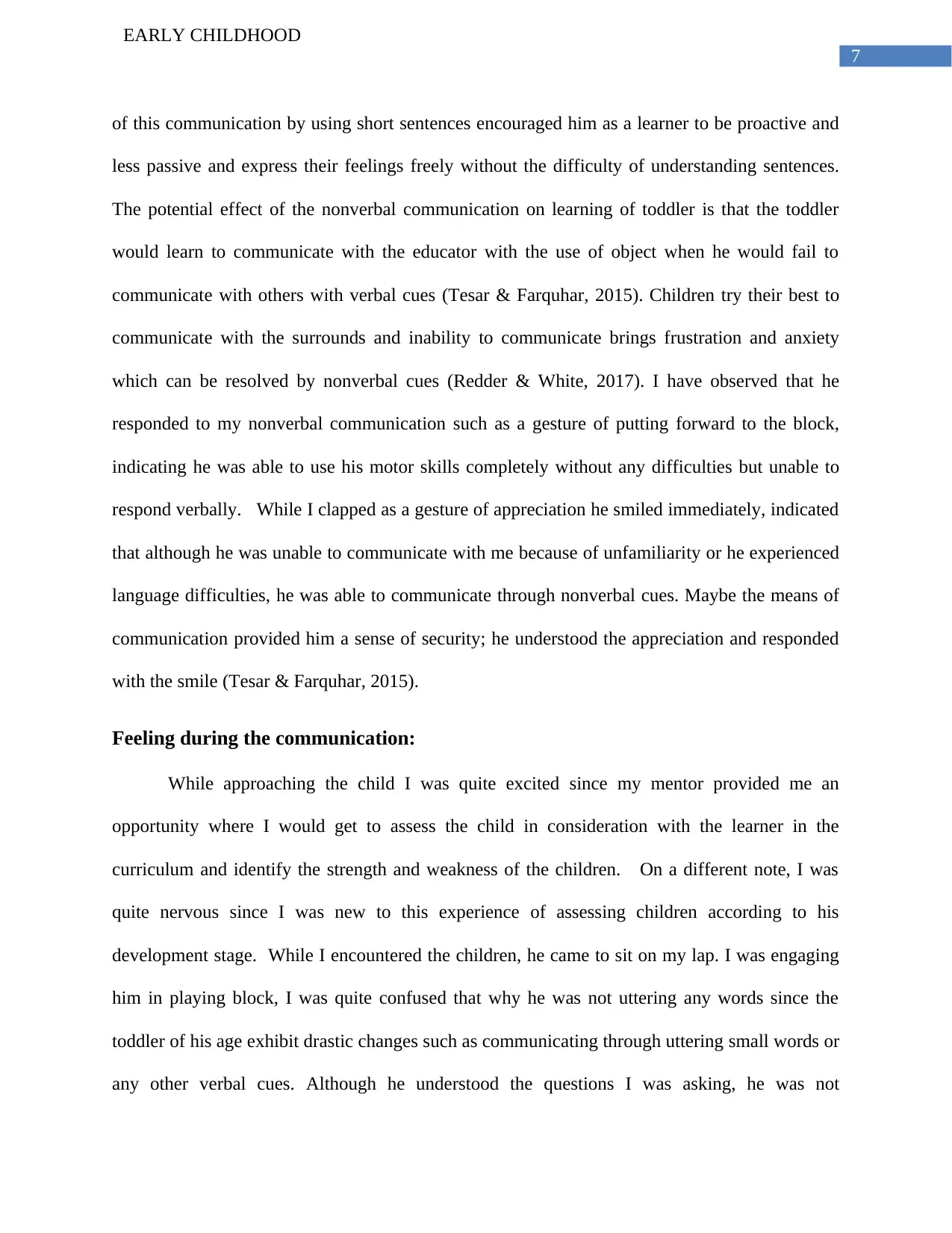
7
EARLY CHILDHOOD
of this communication by using short sentences encouraged him as a learner to be proactive and
less passive and express their feelings freely without the difficulty of understanding sentences.
The potential effect of the nonverbal communication on learning of toddler is that the toddler
would learn to communicate with the educator with the use of object when he would fail to
communicate with others with verbal cues (Tesar & Farquhar, 2015). Children try their best to
communicate with the surrounds and inability to communicate brings frustration and anxiety
which can be resolved by nonverbal cues (Redder & White, 2017). I have observed that he
responded to my nonverbal communication such as a gesture of putting forward to the block,
indicating he was able to use his motor skills completely without any difficulties but unable to
respond verbally. While I clapped as a gesture of appreciation he smiled immediately, indicated
that although he was unable to communicate with me because of unfamiliarity or he experienced
language difficulties, he was able to communicate through nonverbal cues. Maybe the means of
communication provided him a sense of security; he understood the appreciation and responded
with the smile (Tesar & Farquhar, 2015).
Feeling during the communication:
While approaching the child I was quite excited since my mentor provided me an
opportunity where I would get to assess the child in consideration with the learner in the
curriculum and identify the strength and weakness of the children. On a different note, I was
quite nervous since I was new to this experience of assessing children according to his
development stage. While I encountered the children, he came to sit on my lap. I was engaging
him in playing block, I was quite confused that why he was not uttering any words since the
toddler of his age exhibit drastic changes such as communicating through uttering small words or
any other verbal cues. Although he understood the questions I was asking, he was not
EARLY CHILDHOOD
of this communication by using short sentences encouraged him as a learner to be proactive and
less passive and express their feelings freely without the difficulty of understanding sentences.
The potential effect of the nonverbal communication on learning of toddler is that the toddler
would learn to communicate with the educator with the use of object when he would fail to
communicate with others with verbal cues (Tesar & Farquhar, 2015). Children try their best to
communicate with the surrounds and inability to communicate brings frustration and anxiety
which can be resolved by nonverbal cues (Redder & White, 2017). I have observed that he
responded to my nonverbal communication such as a gesture of putting forward to the block,
indicating he was able to use his motor skills completely without any difficulties but unable to
respond verbally. While I clapped as a gesture of appreciation he smiled immediately, indicated
that although he was unable to communicate with me because of unfamiliarity or he experienced
language difficulties, he was able to communicate through nonverbal cues. Maybe the means of
communication provided him a sense of security; he understood the appreciation and responded
with the smile (Tesar & Farquhar, 2015).
Feeling during the communication:
While approaching the child I was quite excited since my mentor provided me an
opportunity where I would get to assess the child in consideration with the learner in the
curriculum and identify the strength and weakness of the children. On a different note, I was
quite nervous since I was new to this experience of assessing children according to his
development stage. While I encountered the children, he came to sit on my lap. I was engaging
him in playing block, I was quite confused that why he was not uttering any words since the
toddler of his age exhibit drastic changes such as communicating through uttering small words or
any other verbal cues. Although he understood the questions I was asking, he was not
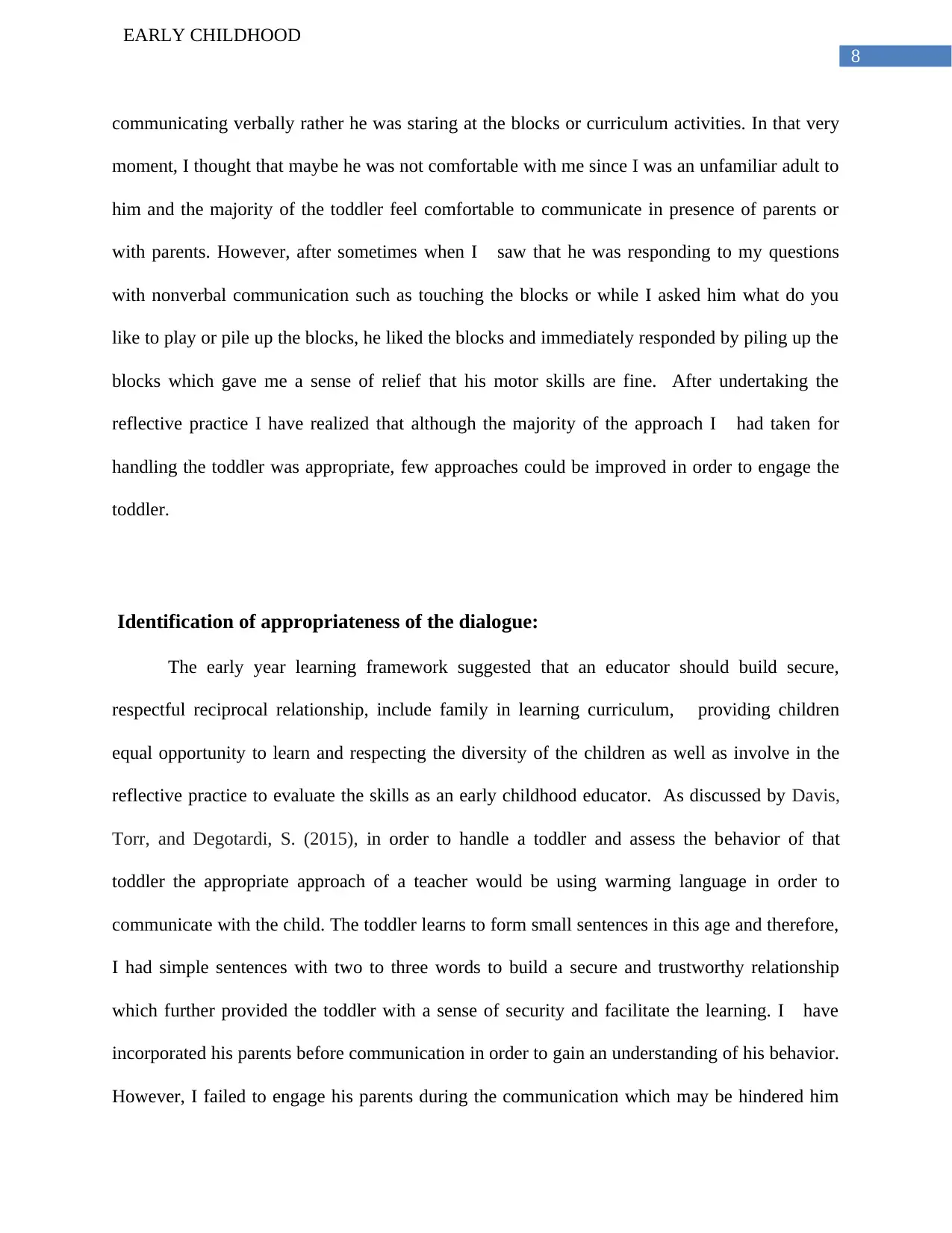
8
EARLY CHILDHOOD
communicating verbally rather he was staring at the blocks or curriculum activities. In that very
moment, I thought that maybe he was not comfortable with me since I was an unfamiliar adult to
him and the majority of the toddler feel comfortable to communicate in presence of parents or
with parents. However, after sometimes when I saw that he was responding to my questions
with nonverbal communication such as touching the blocks or while I asked him what do you
like to play or pile up the blocks, he liked the blocks and immediately responded by piling up the
blocks which gave me a sense of relief that his motor skills are fine. After undertaking the
reflective practice I have realized that although the majority of the approach I had taken for
handling the toddler was appropriate, few approaches could be improved in order to engage the
toddler.
Identification of appropriateness of the dialogue:
The early year learning framework suggested that an educator should build secure,
respectful reciprocal relationship, include family in learning curriculum, providing children
equal opportunity to learn and respecting the diversity of the children as well as involve in the
reflective practice to evaluate the skills as an early childhood educator. As discussed by Davis,
Torr, and Degotardi, S. (2015), in order to handle a toddler and assess the behavior of that
toddler the appropriate approach of a teacher would be using warming language in order to
communicate with the child. The toddler learns to form small sentences in this age and therefore,
I had simple sentences with two to three words to build a secure and trustworthy relationship
which further provided the toddler with a sense of security and facilitate the learning. I have
incorporated his parents before communication in order to gain an understanding of his behavior.
However, I failed to engage his parents during the communication which may be hindered him
EARLY CHILDHOOD
communicating verbally rather he was staring at the blocks or curriculum activities. In that very
moment, I thought that maybe he was not comfortable with me since I was an unfamiliar adult to
him and the majority of the toddler feel comfortable to communicate in presence of parents or
with parents. However, after sometimes when I saw that he was responding to my questions
with nonverbal communication such as touching the blocks or while I asked him what do you
like to play or pile up the blocks, he liked the blocks and immediately responded by piling up the
blocks which gave me a sense of relief that his motor skills are fine. After undertaking the
reflective practice I have realized that although the majority of the approach I had taken for
handling the toddler was appropriate, few approaches could be improved in order to engage the
toddler.
Identification of appropriateness of the dialogue:
The early year learning framework suggested that an educator should build secure,
respectful reciprocal relationship, include family in learning curriculum, providing children
equal opportunity to learn and respecting the diversity of the children as well as involve in the
reflective practice to evaluate the skills as an early childhood educator. As discussed by Davis,
Torr, and Degotardi, S. (2015), in order to handle a toddler and assess the behavior of that
toddler the appropriate approach of a teacher would be using warming language in order to
communicate with the child. The toddler learns to form small sentences in this age and therefore,
I had simple sentences with two to three words to build a secure and trustworthy relationship
which further provided the toddler with a sense of security and facilitate the learning. I have
incorporated his parents before communication in order to gain an understanding of his behavior.
However, I failed to engage his parents during the communication which may be hindered him
⊘ This is a preview!⊘
Do you want full access?
Subscribe today to unlock all pages.

Trusted by 1+ million students worldwide
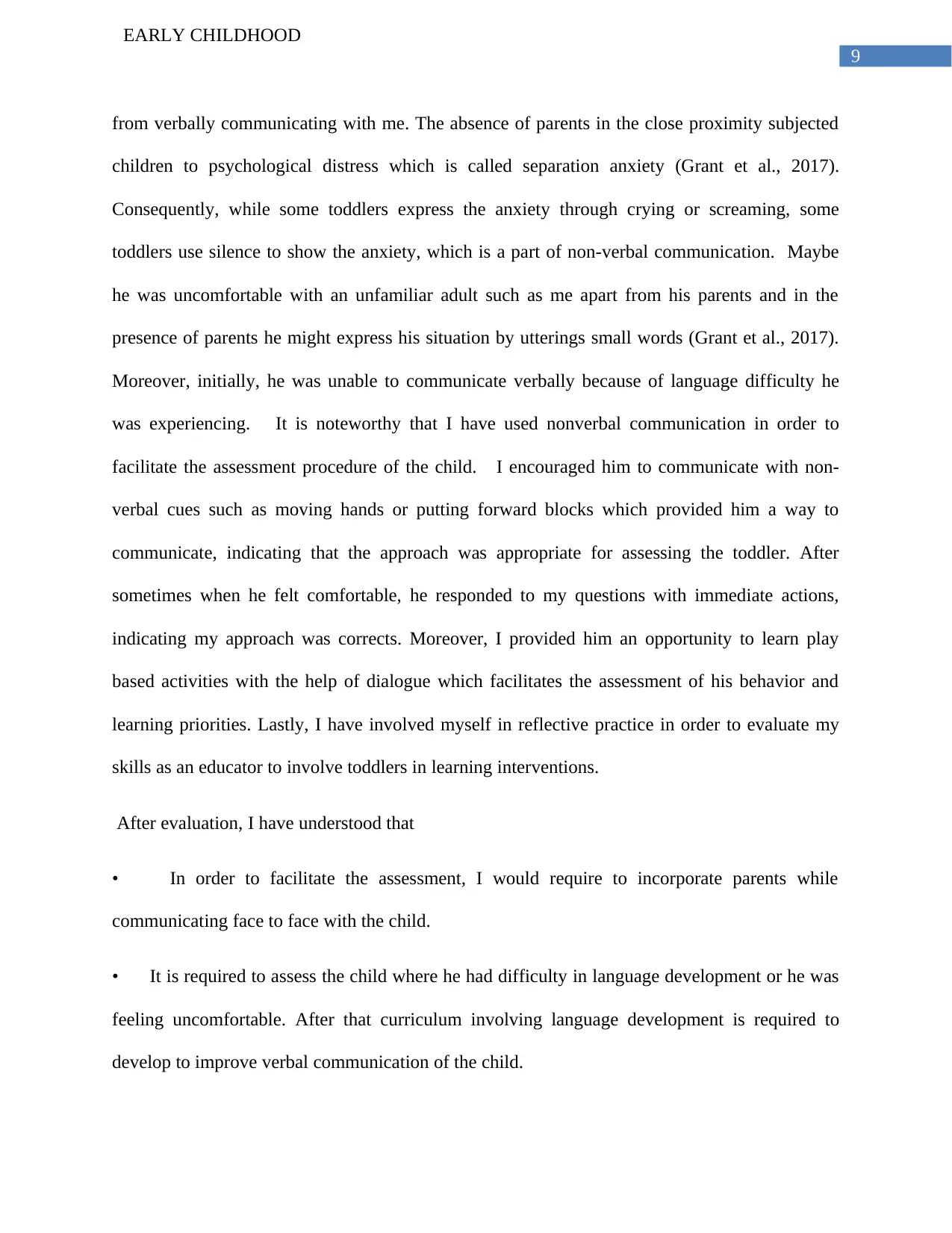
9
EARLY CHILDHOOD
from verbally communicating with me. The absence of parents in the close proximity subjected
children to psychological distress which is called separation anxiety (Grant et al., 2017).
Consequently, while some toddlers express the anxiety through crying or screaming, some
toddlers use silence to show the anxiety, which is a part of non-verbal communication. Maybe
he was uncomfortable with an unfamiliar adult such as me apart from his parents and in the
presence of parents he might express his situation by utterings small words (Grant et al., 2017).
Moreover, initially, he was unable to communicate verbally because of language difficulty he
was experiencing. It is noteworthy that I have used nonverbal communication in order to
facilitate the assessment procedure of the child. I encouraged him to communicate with non-
verbal cues such as moving hands or putting forward blocks which provided him a way to
communicate, indicating that the approach was appropriate for assessing the toddler. After
sometimes when he felt comfortable, he responded to my questions with immediate actions,
indicating my approach was corrects. Moreover, I provided him an opportunity to learn play
based activities with the help of dialogue which facilitates the assessment of his behavior and
learning priorities. Lastly, I have involved myself in reflective practice in order to evaluate my
skills as an educator to involve toddlers in learning interventions.
After evaluation, I have understood that
• In order to facilitate the assessment, I would require to incorporate parents while
communicating face to face with the child.
• It is required to assess the child where he had difficulty in language development or he was
feeling uncomfortable. After that curriculum involving language development is required to
develop to improve verbal communication of the child.
EARLY CHILDHOOD
from verbally communicating with me. The absence of parents in the close proximity subjected
children to psychological distress which is called separation anxiety (Grant et al., 2017).
Consequently, while some toddlers express the anxiety through crying or screaming, some
toddlers use silence to show the anxiety, which is a part of non-verbal communication. Maybe
he was uncomfortable with an unfamiliar adult such as me apart from his parents and in the
presence of parents he might express his situation by utterings small words (Grant et al., 2017).
Moreover, initially, he was unable to communicate verbally because of language difficulty he
was experiencing. It is noteworthy that I have used nonverbal communication in order to
facilitate the assessment procedure of the child. I encouraged him to communicate with non-
verbal cues such as moving hands or putting forward blocks which provided him a way to
communicate, indicating that the approach was appropriate for assessing the toddler. After
sometimes when he felt comfortable, he responded to my questions with immediate actions,
indicating my approach was corrects. Moreover, I provided him an opportunity to learn play
based activities with the help of dialogue which facilitates the assessment of his behavior and
learning priorities. Lastly, I have involved myself in reflective practice in order to evaluate my
skills as an educator to involve toddlers in learning interventions.
After evaluation, I have understood that
• In order to facilitate the assessment, I would require to incorporate parents while
communicating face to face with the child.
• It is required to assess the child where he had difficulty in language development or he was
feeling uncomfortable. After that curriculum involving language development is required to
develop to improve verbal communication of the child.
Paraphrase This Document
Need a fresh take? Get an instant paraphrase of this document with our AI Paraphraser
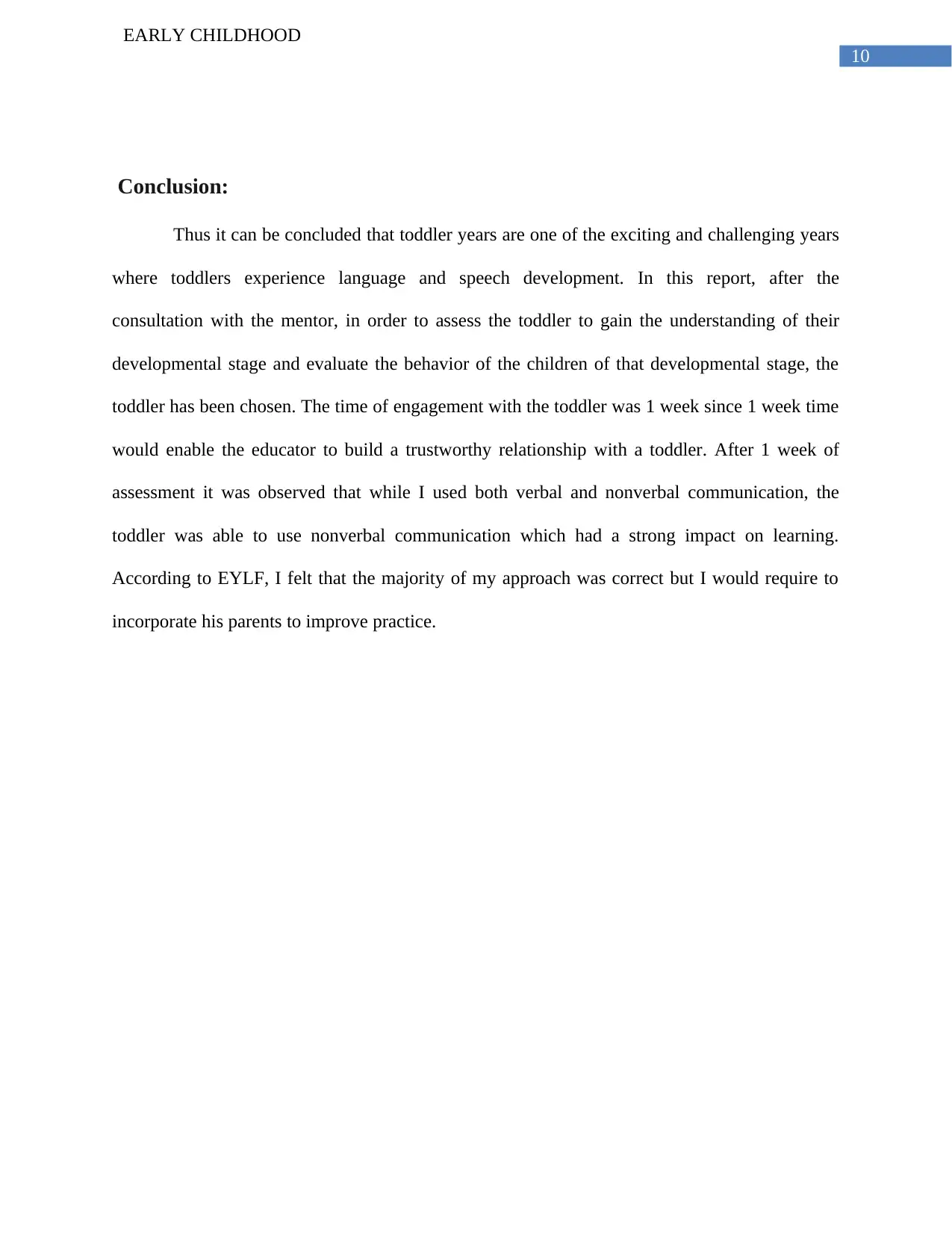
10
EARLY CHILDHOOD
Conclusion:
Thus it can be concluded that toddler years are one of the exciting and challenging years
where toddlers experience language and speech development. In this report, after the
consultation with the mentor, in order to assess the toddler to gain the understanding of their
developmental stage and evaluate the behavior of the children of that developmental stage, the
toddler has been chosen. The time of engagement with the toddler was 1 week since 1 week time
would enable the educator to build a trustworthy relationship with a toddler. After 1 week of
assessment it was observed that while I used both verbal and nonverbal communication, the
toddler was able to use nonverbal communication which had a strong impact on learning.
According to EYLF, I felt that the majority of my approach was correct but I would require to
incorporate his parents to improve practice.
EARLY CHILDHOOD
Conclusion:
Thus it can be concluded that toddler years are one of the exciting and challenging years
where toddlers experience language and speech development. In this report, after the
consultation with the mentor, in order to assess the toddler to gain the understanding of their
developmental stage and evaluate the behavior of the children of that developmental stage, the
toddler has been chosen. The time of engagement with the toddler was 1 week since 1 week time
would enable the educator to build a trustworthy relationship with a toddler. After 1 week of
assessment it was observed that while I used both verbal and nonverbal communication, the
toddler was able to use nonverbal communication which had a strong impact on learning.
According to EYLF, I felt that the majority of my approach was correct but I would require to
incorporate his parents to improve practice.
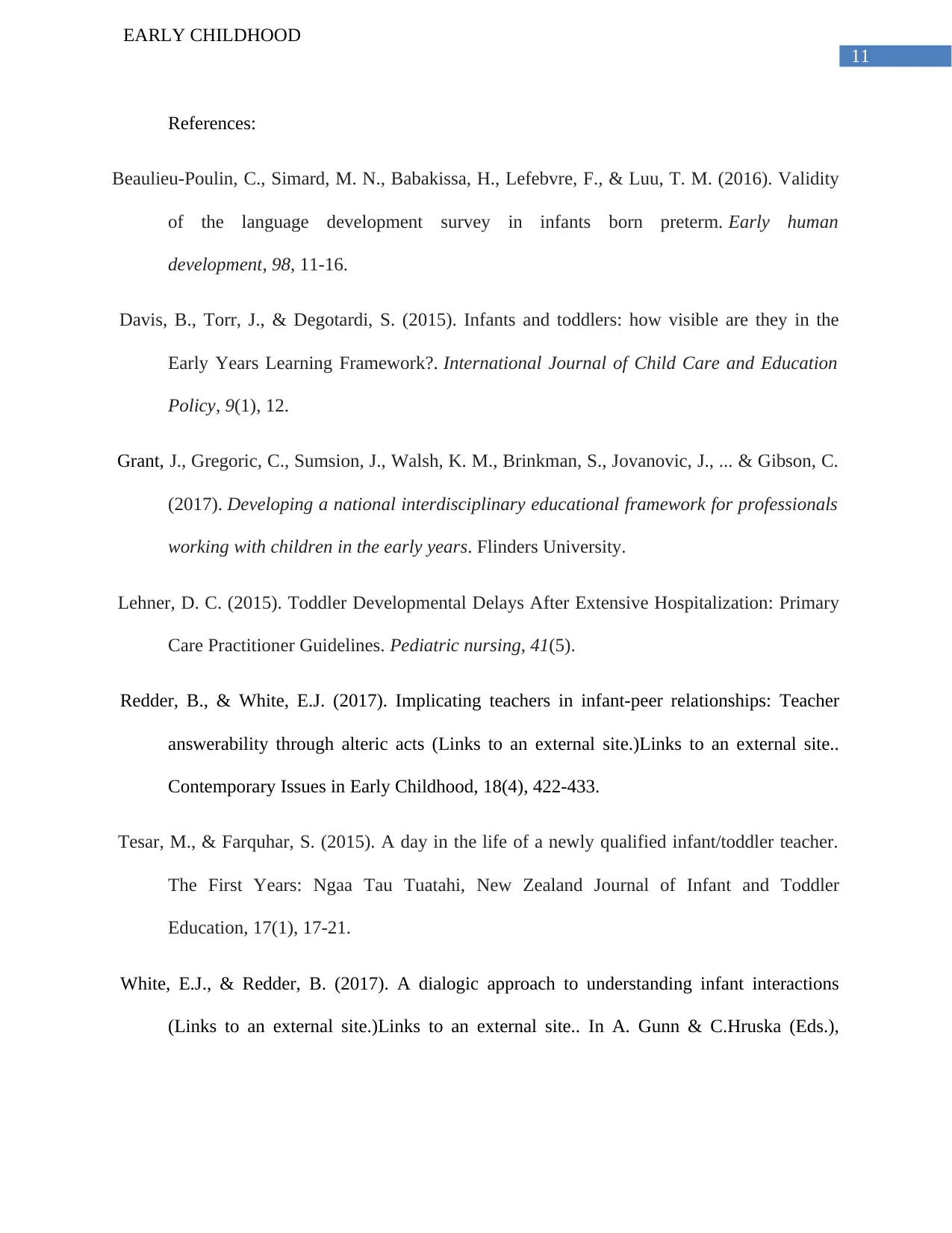
11
EARLY CHILDHOOD
References:
Beaulieu-Poulin, C., Simard, M. N., Babakissa, H., Lefebvre, F., & Luu, T. M. (2016). Validity
of the language development survey in infants born preterm. Early human
development, 98, 11-16.
Davis, B., Torr, J., & Degotardi, S. (2015). Infants and toddlers: how visible are they in the
Early Years Learning Framework?. International Journal of Child Care and Education
Policy, 9(1), 12.
Grant, J., Gregoric, C., Sumsion, J., Walsh, K. M., Brinkman, S., Jovanovic, J., ... & Gibson, C.
(2017). Developing a national interdisciplinary educational framework for professionals
working with children in the early years. Flinders University.
Lehner, D. C. (2015). Toddler Developmental Delays After Extensive Hospitalization: Primary
Care Practitioner Guidelines. Pediatric nursing, 41(5).
Redder, B., & White, E.J. (2017). Implicating teachers in infant-peer relationships: Teacher
answerability through alteric acts (Links to an external site.)Links to an external site..
Contemporary Issues in Early Childhood, 18(4), 422-433.
Tesar, M., & Farquhar, S. (2015). A day in the life of a newly qualified infant/toddler teacher.
The First Years: Ngaa Tau Tuatahi, New Zealand Journal of Infant and Toddler
Education, 17(1), 17-21.
White, E.J., & Redder, B. (2017). A dialogic approach to understanding infant interactions
(Links to an external site.)Links to an external site.. In A. Gunn & C.Hruska (Eds.),
EARLY CHILDHOOD
References:
Beaulieu-Poulin, C., Simard, M. N., Babakissa, H., Lefebvre, F., & Luu, T. M. (2016). Validity
of the language development survey in infants born preterm. Early human
development, 98, 11-16.
Davis, B., Torr, J., & Degotardi, S. (2015). Infants and toddlers: how visible are they in the
Early Years Learning Framework?. International Journal of Child Care and Education
Policy, 9(1), 12.
Grant, J., Gregoric, C., Sumsion, J., Walsh, K. M., Brinkman, S., Jovanovic, J., ... & Gibson, C.
(2017). Developing a national interdisciplinary educational framework for professionals
working with children in the early years. Flinders University.
Lehner, D. C. (2015). Toddler Developmental Delays After Extensive Hospitalization: Primary
Care Practitioner Guidelines. Pediatric nursing, 41(5).
Redder, B., & White, E.J. (2017). Implicating teachers in infant-peer relationships: Teacher
answerability through alteric acts (Links to an external site.)Links to an external site..
Contemporary Issues in Early Childhood, 18(4), 422-433.
Tesar, M., & Farquhar, S. (2015). A day in the life of a newly qualified infant/toddler teacher.
The First Years: Ngaa Tau Tuatahi, New Zealand Journal of Infant and Toddler
Education, 17(1), 17-21.
White, E.J., & Redder, B. (2017). A dialogic approach to understanding infant interactions
(Links to an external site.)Links to an external site.. In A. Gunn & C.Hruska (Eds.),
⊘ This is a preview!⊘
Do you want full access?
Subscribe today to unlock all pages.

Trusted by 1+ million students worldwide
1 out of 13
Related Documents
Your All-in-One AI-Powered Toolkit for Academic Success.
+13062052269
info@desklib.com
Available 24*7 on WhatsApp / Email
![[object Object]](/_next/static/media/star-bottom.7253800d.svg)
Unlock your academic potential
Copyright © 2020–2025 A2Z Services. All Rights Reserved. Developed and managed by ZUCOL.





